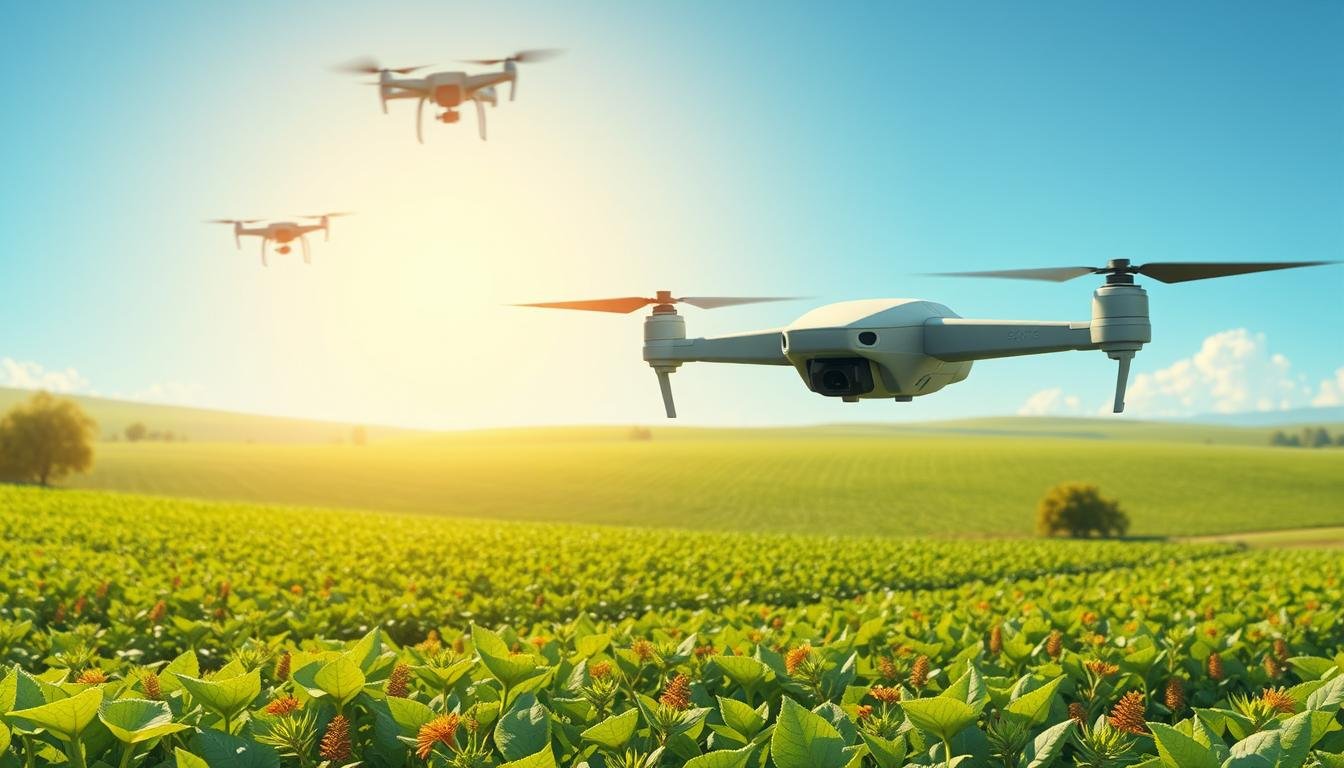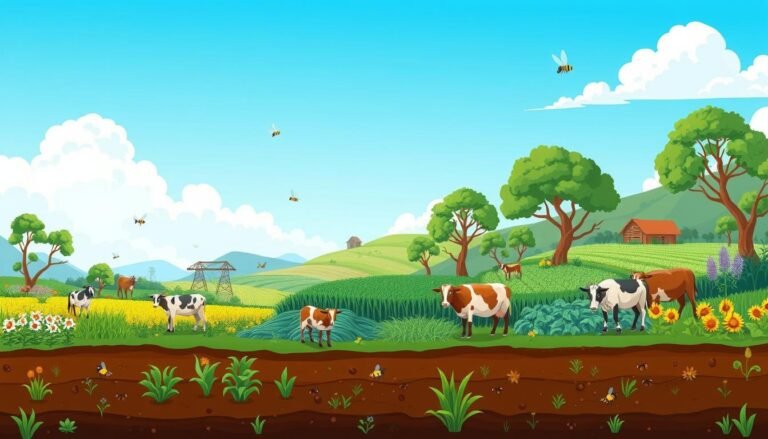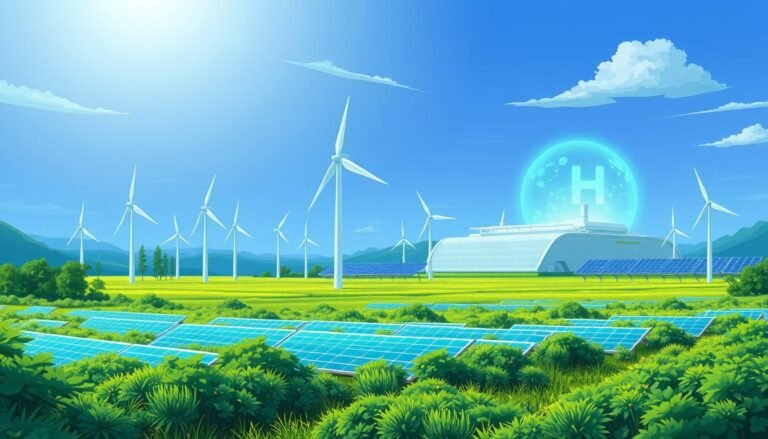Smart Agriculture: The Role of AI and Drones in 2025
Can artificial intelligence and drones really change how we grow food by 2025?
The world needs more food, and we must care for our planet. The farming world is looking for new ways to grow food sustainably. AI in farming and drone technology are leading the way. They promise to make farming more efficient and productive.
In 2025, AI and drones will be a big part of farming. They will help solve problems like not having enough resources and a growing population. These technologies will make farming more accurate and easier for farmers.
Key Takeaways
- The use of AI in agriculture is growing fast, helping crops grow better.
- AI helps with soil health, water use, and growing crops better.
- By 2025, drones in farming will be worth nearly $6 billion.
- Drones give detailed views and help with treatments, making farming smarter.
- AI and drones can increase crop yield and quality, and cut down on pollution by up to 15%.
- Together, AI and drones make farming more efficient and sustainable, meeting global food needs.
Keep reading to learn more about how smart agriculture will change farming in the future.
The Evolution of Smart Agriculture
In recent years, the evolution of farming has moved from old, manual ways to new, tech-based methods. This change is mainly because we need to produce more food, do it in a way that’s good for the planet, and make farming more efficient.
New tech like AI, IoT devices, and drones is changing farming. These tools help farmers use resources better, grow more food, and harm the environment less.
The Current State of Agricultural Technology
Today, current agricultural technology includes things like automated tractors and precision irrigation. These tools help farmers work faster and more accurately. For example, drones with sensors can quickly check on crops over big areas.
AI also helps by analyzing data from drones and sensors. It gives farmers advice on how to use water and fertilizer better. This cuts down on waste and helps the environment. For instance, AI-powered robots can reduce herbicide use by up to 90%, saving money and protecting the planet.
Key Drivers for Technological Adoption
The use of AI and drones in farming is growing fast. This is because we need to grow 70% more food by 2050, and we want to do it in a way that’s good for the planet. Also, using tech can save money and make farming more efficient.
Many farmers see the value in using technology. For example, a winery in California used AI to water its crops better and saw a 26% increase in yields. In Kazakhstan, smart greenhouses use IoT and AI to grow crops more efficiently by adjusting the environment automatically.
| Technology | Benefits | Case Studies |
|---|---|---|
| Drones | Provide real-time data on crop health, monitor large areas quickly | Several farms worldwide have adopted drone technology for efficient crop monitoring. |
| AI Algorithms | Optimize resource use, improve yield prediction accuracy | The ‘See & Spray’ robots by Blue River Technology reduce herbicide use by 90%. |
| IoT Devices | Automate irrigation systems, monitor environmental conditions | Smart greenhouses in Kazakhstan integrate IoT and AI for optimal crop growth. |
As farming keeps evolving, it’s clear that tech is key. The mix of AI, drones, and IoT is leading to a new era of smart farming. This ensures we can feed everyone and protect the planet for the future.
Understanding AI in Agriculture
Artificial Intelligence (AI) is changing farming by making it more precise and efficient. It uses machine learning and predictive analytics to help farmers make better choices. This leads to better crop yields and more productivity. Let’s dive into how these technologies are reshaping farming.
Machine Learning in Agriculture
Machine learning in farming uses algorithms to analyze lots of data. It helps predict crop prices, manage risks, and figure out how many harvesting machines are needed. For example, John Deere’s Blue River See & Spray™ uses computer vision to spot weeds, cutting down on chemical use and crop loss by up to 30%.
It also helps with irrigation scheduling based on soil moisture. This is all part of precision farming.
Predictive Analytics for Crop Yield Optimization
Predictive analytics is a big deal for farmers wanting to boost crop yields. It looks at past data and current conditions to forecast weather, pests, and crop performance. This helps farmers use resources better, possibly cutting down water, fertilizers, and pesticides by up to 35%.
AI can also spot crop diseases early, reducing losses by 20-30%. This makes farming more sustainable and profitable.
AI in farming is not just about better practices. It also cuts down on manual labor, which can drop by up to 50%. Autonomous vehicles like electric tractors and drones do tasks like plowing and seeding. This makes farming more efficient.
These technologies can increase crop yields by 20-30%. This is a big win for global food security and ensuring everyone has enough to eat.
| Key Benefits of AI in Agriculture | Statistics |
|---|---|
| Increased Crop Yields | 20-30% |
| Reduction in Resource Usage | Up to 35% |
| Reduction in Crop Losses | 20-30% |
| Labor Demand Reduction | Up to 50% |
Role of Drones in Modern Farming
Drones have changed farming a lot in recent years. They started as simple cameras in the sky but now have GPS and sensors. This makes them key for checking on crops and helping farmers work better.
Crop Monitoring with Agricultural Drones
Drones with cameras and sensors take detailed pictures of crops. They help farmers spot problems early. For example, they can see if a crop needs more water or food.
Drone tech and AI help find issues that are hard to see. This lets farmers use resources better. It helps them use less water and chemicals, making farming more efficient.
Pest and Disease Management
Drone farming is great for fighting pests and diseases. They can quickly scan big areas for problems. With special sensors, drones give detailed maps for better pest control.
Drone tech also helps predict problems before they start. This lets farmers take action early. It helps avoid big damage and cuts down on chemical use, making farming better for the planet.
| Application | Function | Benefits |
|---|---|---|
| Crop Monitoring | Gathering detailed crop data with cameras and sensors | Precise assessment of crop health and early detection of issues |
| Pest Management | Identifying pest infestations and disease outbreaks | Early intervention and reduced chemical usage |
| Resource Optimization | Applying fertilizers, pesticides, and water efficiently | Reduced waste and increased yields |
Drone technology keeps getting better, making them more important in farming. They help with everything from checking crops to fighting pests. Drones are key to making farming more productive and green.
The Impact of Precision Farming
Precision farming uses AI and drones to change farming. These new tools help farmers use water and resources better. They also watch crops closely, making farming more productive and green.
Optimizing Irrigation with AI and Drones
AI and drones are key for better irrigation in precision farming. They use sensors and cameras to check soil and crops. This helps farmers decide when to water, saving water and helping crops grow.
Farmers use IoT sensors to check soil moisture, temperature, and pH. This lets them water just the right amount. It saves water and makes crops grow better.
Precision Application of Fertilizers and Pesticides
Drones with sensors and AI apply fertilizers and pesticides where needed. This cuts down on waste and helps crops grow strong. Precision spraying uses drones to target chemicals, reducing waste and runoff.
GPS and GNSS help with planting, ensuring seeds are planted right. This boosts crop yields and cuts down on chemicals. It makes farming more sustainable.
| Technology | Benefit | Impact |
|---|---|---|
| Drones with Multispectral Sensors | Real-time monitoring of crop health | Early detection of issues, efficient resource use |
| IoT Soil Sensors | Measurement of soil parameters | Informed irrigation and fertilization decisions |
| GPS and GNSS Technology | Guided precision planting | Maximized crop yields, optimized resource use |
| AI-Powered Predictive Analytics | Harvest and yield predictions | Improved planning and logistics |
Remote Sensing and Data-Driven Agriculture
Remote sensing and data-driven strategies are changing farming. They give insights for better operations. Farmers use real-time data from sensors and drones to make quick, smart choices.
Advanced tools like thermal cameras and multispectral sensors help see what’s not visible. This leads to more precise farming.
Real-Time Data Collection and Analysis
Gathering data in real-time is key in farming today. Drones with advanced sensors check on plant health over big areas. AI drones then analyze this data to spot early signs of stress and predict crop yields.
These insights help farmers grow more and better crops.
Case Studies of Successful Implementation
Many farming examples show how remote sensing and data-driven methods work well:
- The Farmonaut Satellite System: It checks crops daily and predicts yields with AI. This leads to better use of resources, up to 30% more than traditional farming.
- Geospatial Analytics: Farmers use data to plan better. They decide on water, fertilizer, and how to move goods. This makes farming more efficient.
- AI-powered Drones: These drones take detailed pictures and use infrared sensors. They help farmers watch crops closely, saving time and money. This supports farming that’s good for the planet.
Let’s look at some key stats between the Farmonaut Satellite System and old-school farming:
| Feature | Farmonaut Satellite System | Traditional Farming |
|---|---|---|
| Monitoring Frequency | Daily | Weekly/Monthly |
| Resource Optimization | Advanced and Data-Driven | Basic and Experience-Based |
| Early Issue Detection | Pre-Visual Detection | Visible Symptoms |
| Yield Prediction Capability | High with AI | Historical Averages |
| Monitoring Time | Significant Time Savings | Moderate to High |
| Cost-Effectiveness | High | Variable |
| Environmental Impact | Low | Moderate to High |
These examples show how remote sensing and data-driven farming can change things. Using these technologies leads to smarter decisions, better use of resources, and farming that’s kinder to the planet.
Barriers to Adoption and Bridging the Digital Divide
Modern farming tech offers many benefits, but cost, access, and lack of tech skills hold it back. It’s key to close the digital gap in farming to let everyone use these tools.
Affordability and Accessibility Challenges
Buying and keeping up with tech like drones is expensive, especially for small farmers. The digital gap in farming is clear when these tools are too pricey for many. They’re also hard to get to in rural areas because of poor internet and lack of infrastructure.
Also, these tools need tech skills that not all farmers have. This makes it hard for them to use these tools.
To fix this, we need to make tech more affordable and create policies that help. Subsidies and grants can help make these tools more accessible. Here’s a table showing the costs and benefits of different drones:
| Type of Drone | Initial Cost | Key Benefits |
|---|---|---|
| Multi-rotor Drones | $1,500 – $15,000 | Ideal for spraying and close-up inspections, highly maneuverable |
| Fixed-wing Drones | $5,000 – $25,000 | Better for large-scale surveillance, longer flight times |
| Hybrid Drones | $10,000 – $30,000 | Combines benefits of multi-rotor and fixed-wing, versatile usage |
Training and Support for Farmers
Training programs are vital for farmers to adopt new tech. Many farmers lack experience with modern tech, so they need good training. Programs like Drone Didi teach farmers and empower women to use drones.
These programs help all farmers, no matter their background, to use new farming tech fully.
Smart Agriculture: The Role of AI and Drones
In recent years, AI has changed farming, making it more efficient and sustainable. Companies like BASF are introducing AI systems, like Xarvio Field Manager, to places like Japan. This shows how AI and drones can make farming better.
AI helps with irrigation, fertilization, and pest control in farming. It uses sensors and drones to make plans based on real-time data. This improves crop yields.
AI also helps with supply chain logistics. It plans better routes, reducing waste and improving efficiency. In animal care, AI watches over livestock health and behavior, making farms more productive and better for animals.
But, AI in farming also has challenges. It might replace jobs and raise privacy concerns. Farmers and others need to work together to make it work for everyone. They must think about cost and privacy, especially for small farmers.
AI and drones lead to more food, lower costs, and better farming. The world’s population is growing, and the IoT market is too. This makes new farming tech very important.
At the heart of this change is precision agriculture. It uses new tech to grow healthier crops and make farming more sustainable. Better networks like 5G and 6G will help even more, making data collection and analysis faster.
| Smart Farming Technology | Key Benefits |
|---|---|
| AI-Driven Predictive Analytics | Future yield forecasting, optimized resource use |
| Drones and Sensors | Real-time monitoring, precision application of inputs |
| IoT Sensors | Monitoring field conditions, data-driven decisions |
| 5G and 6G Networks | Enhanced connectivity, real-time data transmission |
In summary, AI and drones are key to the future of farming. They help meet the needs of a growing world while keeping farming efficient and sustainable.
Conclusion
The future of farming looks bright as we tackle big challenges and seize new chances. With more people on Earth, we must grow food better and keep farming green. New tech like AI and drones is leading the way, helping farmers use resources wisely and grow more food.
AI is changing farming by making it more precise and accurate. For example, AI drones help apply pesticides better, protecting the environment and saving water. AI also helps spot diseases like apple black rot and track wheat and tomato growth.
Tools like CattleEye’s AI give farmers key info on animal health, boosting milk production. Drones and AI collect and analyze data fast, giving farmers the tools they need to make smart choices. This helps farmers use water and fertilizers better, which is crucial with rising costs and climate change.
Groups like the Global Alliance for Climate-Smart Agriculture and the Bill & Melinda Gates Foundation are working together. They’re pushing for new farming ideas and tools. This teamwork is essential for farming’s future.
In short, technology is making farming more productive and kinder to the planet. With ongoing tech progress, farming is ready to face the food needs of a growing world and fight climate change.
Source Links
- AI in agriculture: everything you need to know in 2025 – Qaltivate
- The Benefits of Drones in Agribusiness | Travelers Insurance
- Exploring Smart Farming Technologies Powered by AI
- Smart Agriculture and Food Security: The Role of Drones and AI in Precision Farming
- Farming in the Digital Age: Smart Agriculture with AI and IoT
- What Is Smart Farming? | IBM
- AE589/AE589: Understanding Artificial Intelligence: What It Is and How It Is Used in Agriculture
- AI in Agriculture: Its Pros and Cons
- Revolutionizing Agriculture: The Role of Robotics, AI, and Big Data in Modern Farming
- The Rise of Drones in Modern Agriculture
- The Role of Technology in Modern Farming: From Drones to Data Analytics
- What Is The Role of AI in Smart Agriculture?
- Agri-Drones and Remote Sensing
- How Remote Sensing and Drones are Transforming Crop Monitoring and Sustainable Food Production
- How Remote Sensing and AI Drive Precision Farming Innovation
- Empowering Farmers with Drone Technology: Bridging the Digital Divide in Agriculture
- Future of sustainable farming: exploring opportunities and overcoming barriers in drone-IoT integration – Discover Sustainability
- Application of Artificial Intelligence in the Agricultural Industry | YCP
- Smart Farming: The Role of AI and IoT in Agriculture
- AI in Agriculture — The Future of Farming
- Autonomous Drones and AI: Revolutionizing Agriculture – MulticoreWare








